FINDING THE VOLUME AND THE SURFACE AREA OF A SPHERE
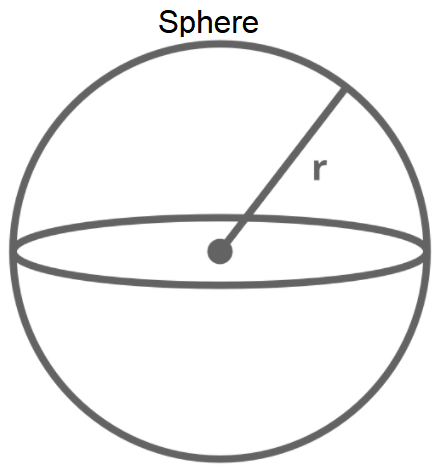
Formula for surface area of a sphere,
S = 4πr²
Formula for volume of a sphere
V = (4/3)πr³
(where r is the radius of the sphere)
Find the surface area of the sphere. Round your answer to the nearest whole number.
Problem 1 :
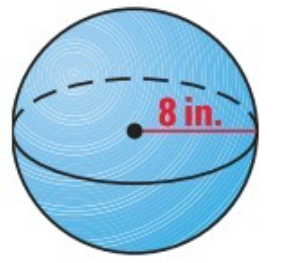
Solution :
Given, radius = 8 in
Formula for surface area of a sphere
S = 4πr²
Substitute π = 22/7 and r = 8
S = 4π (8)²
S = (4) (22/7) (64)
S = 804.57 in²
The surface area of the sphere is 804 in².
Problem 2 :
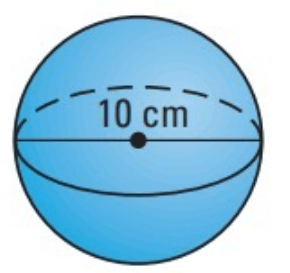
Solution :
Given, Diameter = 10cm.
Radius = d/2
= 10/2
Radius = 5 cm
Formula for surface area of a sphere,
S = 4πr²
Substitute π = 22/7 and r = 5
S = 4π (5)²
S = (4) (22/7) (25)
S = 314.28
The surface area of the sphere is 314 cm².
Find the volume of the sphere. Round your answer to the nearest whole number.
Problem 3 :

Solution :
Given, Radius = 8 m
Formula for volume of the sphere
V = 4/3πr³
Substitute π = 22/7 and r = 8m
V = (4/3) ∙ (22/7) ∙ (8)³
V = (4/3) ∙ (22/7) ∙ 512
V = 2145 m³
Problem 4 :
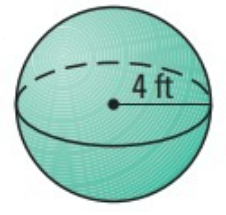
Solution :
Given, Radius = 4 ft
Formula for volume of the sphere
V = 4/3 ∙ πr³
Substitute π = 22/7 and r = 4 ft
V = (4/3) ∙ (22/7) ∙ (4)³
V = (4/3) ∙ (22/7) ∙ 64
V = 268 ft³
Problem 5 :

Solution :
Given, diameter = 22 yd
Radius = d/2
= 22/2
Radius = 11 yd
Formula for volume of the sphere
V = 4/3 ∙ πr³
Substitute π = 22/7 and r = 11 yd
V = (4/3) ∙ (22/7) ∙ (11)³
V = (4/3) ∙ (22/7) ∙ (1331)
V = 5577 yd³
Problem 6 :
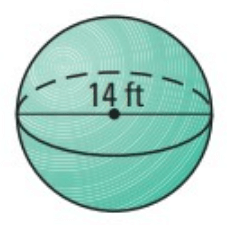
Solution :
Given, diameter = 14 ft
Radius = d/2
= 14/2
Radius = 7 ft
Formula for volume of the sphere
V = 4/3 ∙ πr³
Substitute π = 22/7 and r = 7 ft
V = (4/3) ∙ (22/7) ∙ (7)³
V = (4/3) ∙ (22/7) ∙ (343)
V = 1437 ft³
Problem 7 :
The surface area of a sphere is 324π square centimeters. Find the volume of the sphere.
Solution :
Surface area of sphere = 324 π square centimeters
4πr² = 324π
r² = 324π / 4π
r² = 81
r = √81
r = 9
Volume of sphere = 4/3 ∙ πr³
= (4/3) ∙ π(9)³
= 972 π cm³
Problem 8 :
Find the volume of the composite solid.
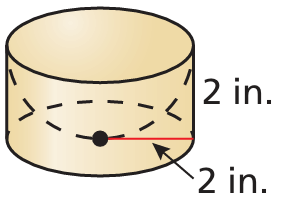
Solution :
Radius = 2 inches and heigth = 2 inches
= Volume of cylinder - volume of hemisphere
= πr2 h - (2/3) πr3
= πr2(h - 2r/3)
= 3.14(2)2(2 - 2(2)/3)
= 12.56 (2 - (4/3))
= 12.56 (6 - 4)/3
= 4.18(2)
= 8.37 cubic inches
Problem 9 :
Find the radius of a sphere with a surface area of 4π square feet.
Solution :
Surface area of sphere = 4π square feet
4πr2 = 4π
r2 = 1
r = 1
So, the radius of the sphere is 1 feet.
Problem 10 :
Find the radius of a sphere with a surface area of 1024π square inches.
Solution :
Surface area of sphere = 1024π square feet
4πr2 = 1024π
r2 = 1024π/4π
r2 = 256
r = 16
So, the radius of the sphere is 16 inches
Problem 11 :
Find the diameter of a sphere with a surface area of 900π square meters.
Solution :
Surface area of sphere = 900π square meters.
4πr2 = 900π
4r2 = 900
r2 = 900/4
r2 = 225
r = 15
diameter = 2r ==> 2(15)
= 30 meter
So, the required diameter of the sphere is 30 meter.
Problem 12 :
Find the diameter of a sphere with a surface area of 196π square centimeters.
Solution :
Surface area of sphere = 196π square meters.
4πr2 = 196π
4r2 = 196
r2 = 196/4
r2 = 49
r = 7
Diameter = 2r ==> 2(7)
= 14 cm
So, the required diameter of the sphere is 14 cm.
Problem 13 :
You friend claims that if the radius of a sphere is doubled, then the surface area of the sphere will also be doubled. Is your friend correct? Explain your reasoning.
Solution :
Let r be the radius of the sphere
Surface area of sphere = 4πr2
When radius is doubled, then new radius will be 2r
Surface area of new sphere = 4π(2r)2
= 4π(4r2)
= 16πr2
= 4(4πr2)
= 4(Surface area of old sphere)
So, your's friend argument is incorrect.
Problem 14 :
A semicircle with a diameter of 18 inches is rotated about its diameter. Find the surface area and the volume of the solid formed.
Solution :
When rotating the shape semicircle, we get the shape hemisphere
Diameter of hemisphere = 18/2
= 9 inches
Surface area of hemisphere = 2πr2
= 2 x 22/7 x 92
= 308 square inches
Volume of hemisphere = (2/3)πr3
= (2/3) x 3.14 x 93
= 16106.04 cubic inches
Problem 15 :
A silo has the dimensions shown. The top of the silo is a hemispherical shape. Find the volume of the silo.
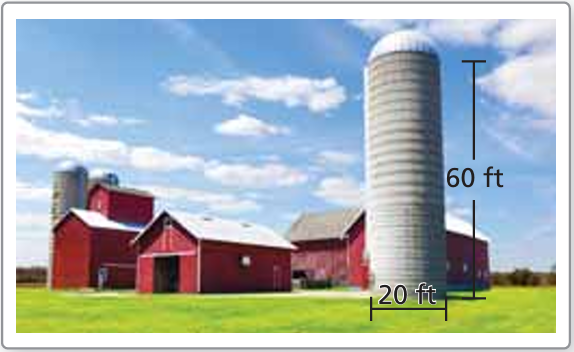
Solution :
Volume of silo = volume of cylinder + volume of hemisphere
= πr2 h + (2/3) πr3
radius (r) = 10 ft and height (h) = 60 ft
= π(10)2 (60) + (2/3) π(10)3
= 6000π + (2000/3)π
= 6666.6π(approximately)
Recent Articles
-
Finding Range of Values Inequality Problems
May 21, 24 08:51 PM
Finding Range of Values Inequality Problems -
Solving Two Step Inequality Word Problems
May 21, 24 08:51 AM
Solving Two Step Inequality Word Problems -
Exponential Function Context and Data Modeling
May 20, 24 10:45 PM
Exponential Function Context and Data Modeling